The Journey
By Ian Altman and David Barnett
Original publication on
Alpinist Magazine Online 2008
|
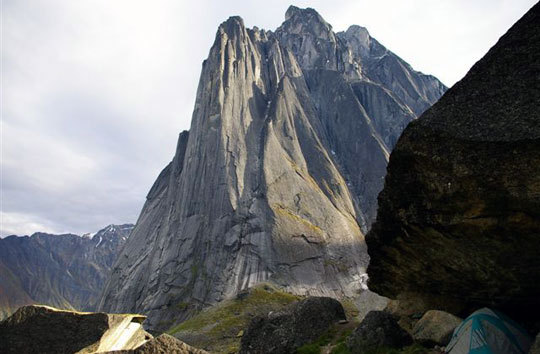
|
|
Ian and Dave's basecamp at Fairy Meadows, below the Lotus Flower Tower.
The Tower, first ascended in 1968, had been a goal of Ian's since he was a teenager. [Photo] Ian Altman
|
The following essay offers two perspectives on one climb--and one life.
The Journey
"Hello” ....I'm a new person now. My name is Ian Altman and I've come to visit this place called reality. I'm now presently stuck inside a shell which continues to malfunction. Its so real here, I'm having trouble distinguishing between where I came from and where I'm going. Is this place called "the present" my only choice? Can I move on beyond and explore the future? What lies ahead is uncertain for sure but it will most definitely include remnants of today. How does one move-on faced with such unpleasant foreshadowing?
I’m believer in positive thinking. But in August I found myself wondering about the disconnect between believing in the bright side and giving it lip service. On a trip to the Lotus Flower Tower in Canada’s Cirque of the Unclimbables, Ian Altman and his multiple sclerosis showed me how unyielding persistence can bridge this gap.
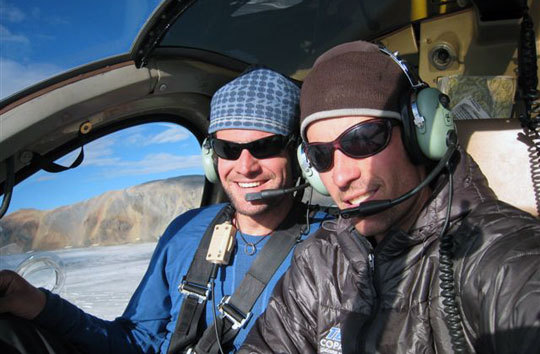
|
|
Ian Altman and David Barnett taking a self portrait while flying into the Cirque of the Unclimbables, Yukon, Canada. [Photo] Ian Altman
|
Since I was about 12 years old I knew I wanted to be climber. This chosen identity became even further engraved in my persona as I grew older and developed Multiple Scleroses at the ripe old age of 24.
Multiple sclerosis (MS) is an autoimmune disease that results in the loss of the myelin that surrounds and protects the central nervous system. The destruction of myelin and nerve fiber disrupts electrical impulses to and from the brain and results in variable symptoms that may include fatigue, vision problems, numbness, and difficulty walking.
MS hit me real hard in the beginning. It was 1997, and I had just finished college. All of the sudden I couldn’t feel my legs. Then--after this initial shocker and a short remission--went my eyes, the strength in my legs, and my balance. The symptoms waned at points, but always left me with some lasting disabilities. With a sense of urgency, I began to attempt the peaks I never thought I’d get a chance to climb again.
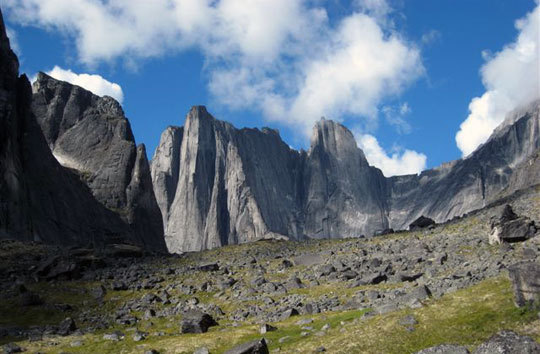
|
|
The Cirque of the Unclimbables is a small cluster of peaks and walls in a remote region of the MacKenzie Mountains near the border of the Yukon and Northwest Territories, just outside Nahanni National Park. [Photo] Courtesy of Ian Altman
|
The stories of Ian’s positive outlook are powerful. Even after a 50-foot climbing fall eight years ago left him with a smashed back and shattered heels his outlook remained bright, and he willed his body to work. Copaxone, a product of Teva Neuroscience, keeps MS at bay, and keeps Ian climbing through an enviable sponsorship that has paid for numerous expeditions, including our journey to the Cirque, located in the far reaches of the Yukon. Says Ian, “It’s a perfect climbing sponsorship because they support me in attempting some far out climbs and they don’t expect me to climb 5.12. All I have to do is have fun!
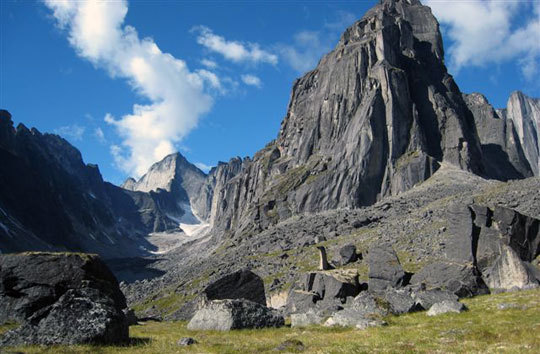
|
|
Mt. Probocis rises precipitously from Fairy Meadows. [Photo] Courtesy of Ian Altman
|
In 1998 I went to the Patagonian Andes where I climbed two granite spires from the famed skyline that Yvon Chouinard had forever embroidered into the aspirations of myself and generations of climbers.
On our first go on the 2,000 foot southeast face of the Lotus Flower Tower (first climbed in 1968 by Jim McCarthy, Tom Frost and Sandy Bill), we got to a large ledge halfway up. Here began the truly brilliant climbing. Ian started up a beautiful layback corner, but after thirty feet of progress, slowed when difficulties seemed to surpass the grade. As the power and feeling in his legs drained so did my confidence.

|
|
On the scree slopes of the approach to Lotus Flower Tower.
The tower is most well known from its inclusion in Steck and Roper's Fifty Classic Climbs.
[Photo] Courtesy of Ian Altman
|
The last time I saw similar symptoms was at Colorado’s Penitente Canyon, not long after Ian’s MS diagnosis. I had winced and grimaced for Ian when he didn’t feel his flip-flopped toes whacking rocks. Ian had to climb with his heels, and we sat in the shade to avoid heat-related complications. The cold night provided no relief. Morning brought nausea, and when Ian tried to walk he looked like a child who had just spun in circles for trying to get dizzy. He staggered fifteen paces, collapsed and puked.
My disease progressed rapidly in the first three years. I soon couldn’t even walk at points--a shocking reminder that I should keep climbing. So I kept at it, and learned to adapt. I found Copaxone and other ways of managing my illness and to this day have been driven by something that I wouldn’t trade back.

|
|
David Barnett leading the first pitch of the "truly brilliant" climbing on the Lotus Flower Tower.
The crack system begins in a ledge ca. 400 feet up the face. [Photo] Ian Altman
|
My mind spiraled as the next several pitches of the Lotus Flower Tower dragged on. Despite a sixteen year friendship, Ian and I have shared a rope only a handful of times, and I realized I was not very familiar with his climbing since MS. What if Penitente-like symptoms surfaced? The weather deteriorated and the summit loomed still hundreds of feet above. On a route where moving fast was the game, Ian repeatedly tapped at the wall with each heel, climbing as if by braille. Still, he wanted to keep going. His words of encouragement did not match my perception of how he must be feeling. I convinced him that the hats and insulated coats we were already wearing would help little during a three hour rappel in rain or snow. During the descent I had time to wonder if Ian pushed the positive prescription beyond benefit. Did forcing it work?
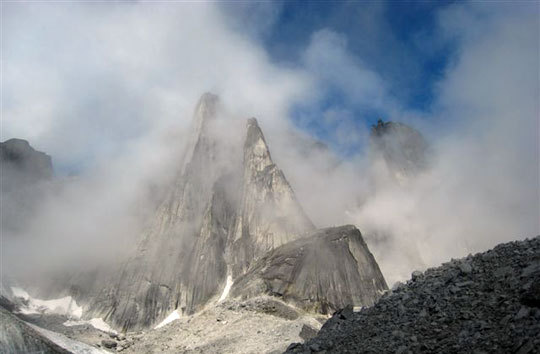
|
|
On their second attempt on Lotus Flower Tower, both questionable weather and a few unplanned diggers on the part of Ian precluded any climbing.
|
After several days of rest and rain we gave the wall another go, despite low clouds and high humidity. “What a great day!” Ian announced as we set off in the dark. I grunted in agreement, trying to see it as such. How were his symptoms really? Moments later his sticky rubber approach shoes betrayed him as he slipped off a wet boulder and whacked a knee. Continuing, we discussed the need to listen to the body, and I suggested baby steps: if he did not really feel that ‘it was a great day,’ perhaps we should lower our expectations. No response. Ian was gone. He’d pitched off the bus-like boulder bridging the transition from grass to glacier — the only no-fall spot on the entire approach. Somehow, Ian escaped with only a big flapper on his thumb. Perhaps he didn’t want to hear my sermon.
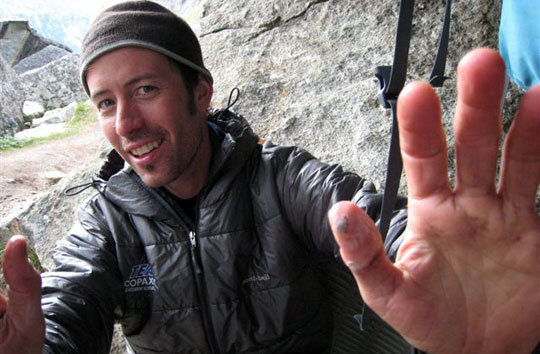
|
|
Ian proudly displaying his only injury of the day--a thumb flapper sustained during a fall off a bus-sized boulder on the approach. [Photo] David Barnett
|

|
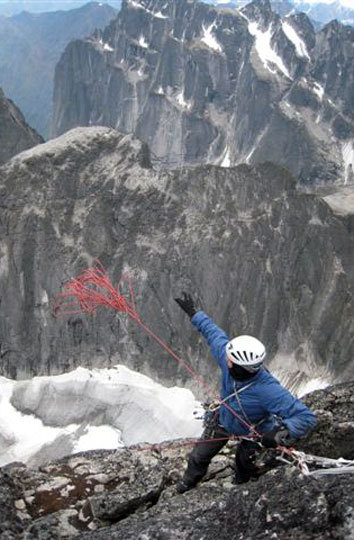
|
|
Exposure. [Photo] Ian Altman
|
Tossing the ropes for the first of many rappels down the route. [Photo] Ian Altman
|
We spent the morning napping at the base of the route and I decided to keep my mouth shut. Clearly, he had a system that worked, having made three successful climbing trips to Patagonia, first ascents in the Bugaboos, and is the founder and a yearly participant in the CT Jamboree, an annual mountain bike ride for MS awareness.
I became fixated on many mountains throughout the world but one that had always remained in my dreams was the 2000 foot southeast face of Lotus Flower Tower. This mountain had become a focal point in my climbing career since I developed MS and finally reaching its summit left me with a powerful epiphany. And as many climbers and mountaineers will tell you- the top is not all that matters! I realized that it was more about the journey then the destination.
Two days later we enjoyed beautiful weather, fine health and splitter cracks that deserve their place in Roper and Steck’s Fifty Classic Climbs, climbing to the top in ten hours flat. During our final days in the meadows below those granite spires, Ian said MS was one of the best things that ever happened to him. It motivates and inspires him, and forces him to find ways to feel good.
Being around him forced me to do the same.

|
|
Ian Altman on the Summit of Lotus Flower Tower after their third attempt on the pinnacle. [Photo] David Barnett
|
Looking back, I see now what a valuable source of humility I was given. I soon learned that climbing could become a useful tool for both understanding and controlling my illness. Today, after living with MS for ten years, I feel even more drawn to the rocky, icy steeps of the world and truly see my disease as a gift which has given me the motivation and courage to go big in the realm of alpine climbing.
--Ian Altman
--David Barnett
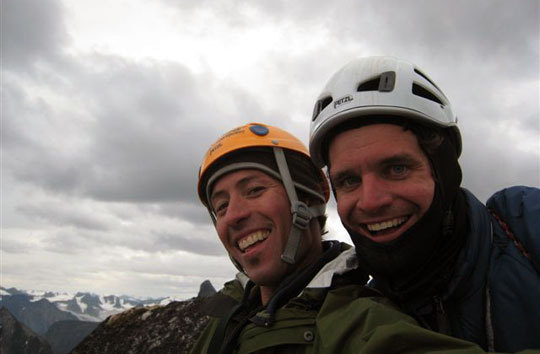
|
|
Self portrait of Ian and David on the summit of Lotus Flower Tower. The pair ascended the Southeast Face Route (V 5.10) on their third attempt. [Photo] Courtesy of Ian Altman
|
Bios: Ian is currently the director of Colorado Timberline Academy’s art department and the head of the school’s accomplished climbing program. When he is not busy sharing his climbing wisdom, Ian keeps himself connected with the outdoors by participating in summit climbs all over the world. To date, Ian has successfully reached the summits of Poincenot in Southern Patagonia, Argentina, Aguja de La S in Patagonia, Argentina, Aguja Innominata in Patagonia, Argentina, Aguja Guillaumet in Patagonia Argentina, a ‘first ascent’ on the North Crescent Spire in British Columbia, the West Buttress of the South Houser Spire in British Columbia, and the Lotus Flower Tower in the North West Territories of Canada.
David Barnett is a two-time Ritt Kellogg Fund recipient, a 1996 Colorado College Graduate and a Ritt Kellogg Fund Advisory Committee member since 1998. During the inaugural grant season in 1995, David ascended Mt. Sliverthrone in the Alaska Range. In 1996, his second grant allowed him to ascend the Sultana Ridge of Mt. Foraker also in the Alaska Range. David has more than fifteen years of rock and alpine climbing experience and his record of accomplishment includes adventures in Yosemite, the Bugaboos, the Tetons, the North Cascades, Rocky Mountain National Park the Black Canyon and Canyonlands. David has extensive experience as an outdoor educator, from which he has gained a keen understanding of wilderness safety and environmental ethics. He is currently a fellow of the Natural Resource Ecology Lab based in Fort Collins, Colorado, where his invasive species research work keeps him close to the public and private grant funding pros.











